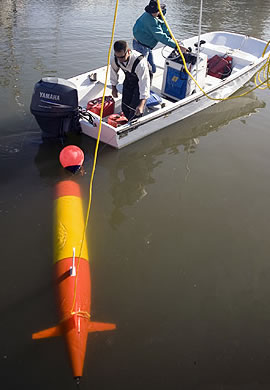Now a new underwater robot has this capability and is apparently able to function in the ocean for months, allowing scientists to study life in the open ocean like never before.
The trial of the robot conducted at Monterey Bay in California was said to be successful. The creator of the underwater robot Jim Bellingham said that it was a revolution in vehicles and it would change how we do oceanography.
The robot called Tethys is designed to follow organisms and simultaneously record the physical and chemical properties of the water around them. Its first experiment involved tracking algal blooms for a week in Monterey Bay. It will cost $140,00 which is cheap enough for individual labs to buy.
 MBARI researcheres towing Tethys behind a small boat in Moss Landing Harbor. Image credit: Todd Walsh © 2010 MBARI
MBARI researcheres towing Tethys behind a small boat in Moss Landing Harbor. Image credit: Todd Walsh © 2010 MBARI
Tethys will reduce the costly and time consuming ship voyages that oceanographers need to undertake for experiments. They will now be able to receive data via satellite and study undersea organisms from the shore.
In "high-speed mode" the LRAUV can travel up to one meter per second (2.25 miles an hour) - about four times faster than most underwater gliders. However, it can also travel long distances at around half this speed.
In Greek mythology, Tethys (Greek Ôçèýò), daughter of Uranus and Gaia was an archaic Titaness and aquatic sea goddess